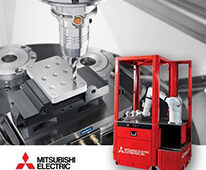Traditional piecemeal compensation of one axis at a time does not consider axis kinematic relationships and their effect on volumetric accuracy, an ability needed to meet today’s higher cutting accuracy requirements. The multi-axis methodology of volumetric error compensation (VEC) originated in Boeing R&D, St. Louis MO, and uses laser technology from Automated Precision, Inc. (API), Rockville MD.
Executives at MAG recently announced what they claim to be the “industry’s fastest VEC system,” the MAG VEC, which analyzes and corrects positioning errors in all machine-tool axes simultaneously reducing the time needed to determine error compensations from days to hours, and integrating both linear and rotary axes into the tool point compensation process, noted Jim Dallam, MAG’s VEC product manager.

Developed and proven by a government/industrial consortium, multi-axis VEC was developed to improve machining accuracies on large machine tools used to produce today’s large, monolithic and complex-shaped parts. The MAG system received a Defense Manufacturing Excellence Award from the National Center for Advanced Technologies (NCAT) in December 2009. A Boeing official called it a “groundbreaking process” that will dramatically reduce assembly and fitting costs — $100 million a year on large programs like the F-18 or 700 aircraft series.
“It gives you a practical and affordable way to raise a machine’s process capability, typically in less than a day, to meet the tighter accuracies required on new parts and programs in the aerospace industry,” said Dallam. “It’s one thing to hold tight tolerances over short distances along a linear axis, but it’s far more difficult along all arbitrary contours and orientations within a volume encompassing several meters.”
Multi-axis VEC collectively treats all of a machine’s degrees of freedom that affect tool point positioning, unlike conventional calibration methods that sequentially examine machine motion one axis at time. Conventional approaches to volumetric compensation are generally limited to three linear axes and the associated total of 21 potential motion error sources. However, a typical five-axis machine with linear and rotary axes can have 43 potential error sources, not just 21. The multi-axis VEC system compensates for all these.
“Dallam said. “The MAG VEC considers the full interrelated effects from the kinematic stack-up of the machine tool axes. This holistic methodology enables volumetric error compensation for every point orientation and path combination inside the work volume.”
To operate, an NC program positions the Active Target to a cloud of some 200 points representing a series of statistically random multi-axis “poses” within the work envelope. The same NC program is run three times, first with the Active Target at a long tool length, then twice again at a short tool length. The 200 commanded and measured positions from the first two runs are mathematically combined to establish each tool axis vector orientation and the third run gives a measure for repeatability. Automated software processes all pose/point data as simultaneous polynomial equations to determine volumetric compensation based on the kinematic error model of the machine.

The compensation solution is then entered into the control, where “compile cycle” technology integrates the compensations into real-time CNC path control algorithms. The volumetric accuracy compensations work in conjunction with, and on top of, traditional, underlying single axis and cross-axis comps.
Measurements are automated within a single coordinate system using laser tracker technology, a simple metrology tool that does not require extensive training to use. Calibration is performed in just a few hours in a single setup, compared to conventional methods that require multiple setups and several days of time, yet fail to capture volumetric axis interactions.
Boeing, MAG, API and Siemens were members of the industry/government consortium that developed the VEC under the program for Volumetric Accuracy of Large Machine Tools (VALMT). Other participants were the National Center for Manufacturing Science, U.S. Air Force Logistics Center, Naval Foundry and Propeller Center, U.S. Navy Fleet Readiness Center, East, and U.S. Army Anniston Depot. The system was tested and proved out on three large machine tools offering different axis configurations.
MAG
www.mag-ias.com
::Design World::
Filed Under: Factory automation, Machine tools + subtractive manufacturing, Lasers, Mechatronics





Tell Us What You Think!